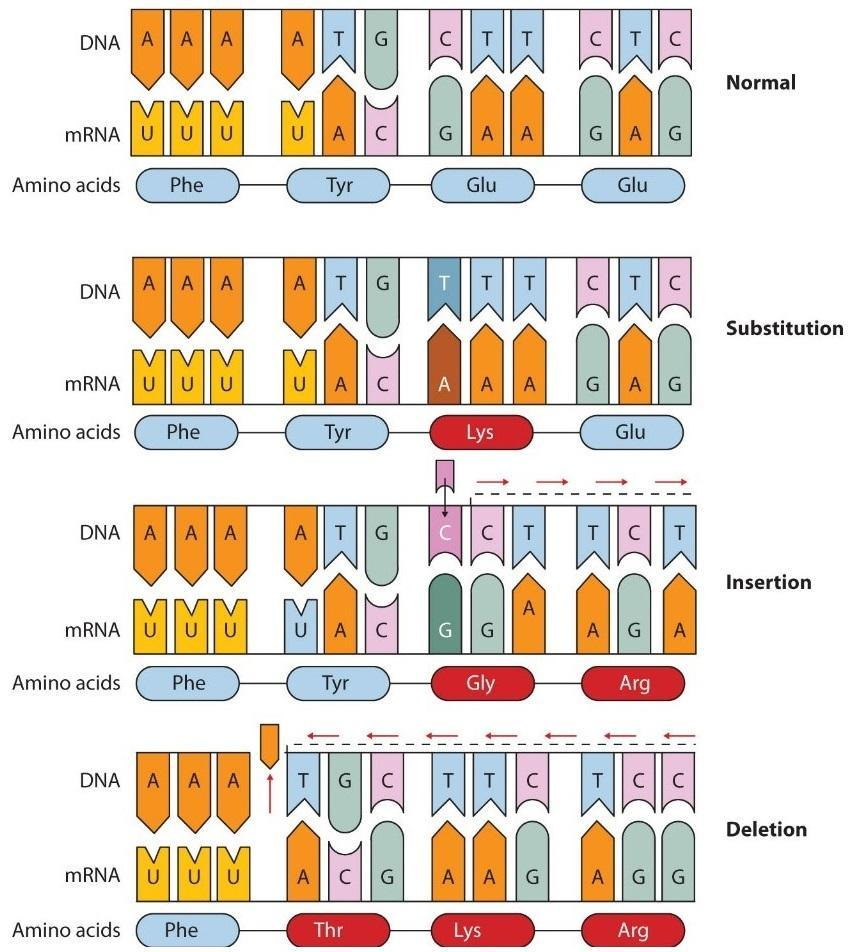
Point mutation is
(A) Loss of gene
(B) Change in a base of gene
(C) Addition of a gene
(D) Deletion of a segment
Answer
567.6k+ views
Hint: Point mutation is defined as the changes in the genome in which the single nucleotide base is made inserted, deleted or changed in the existing nucleotide sequence. In this process not all the entire DNA or RNA is altered only the required nucleotide is changed and this results in the disease.
Complete step by step answer:
Nucleotides are the basic building block of the whole DNA or RNA structure. These are made up of the chemicals like cytosine, guanine, thymine in DNA and uracil in RNA and adenine. The point mutation is of three types.
(1) Substitution:

This mutation occurs by substituting the one base pair of the nucleic acid with the pair. These are of three types as nonsense, missense, and silent substitution mutations.
(2) Insertion:
In this type of mutation, a new nucleotide base is inserted or added to the existing nucleotide sequence.
(3) Deletion:
Deletion mutation is defined as the removal of the particular base pair from the DNA or RNA nucleotide series.
Hence the point mutation is the change in the base of the gene.
So, the correct answer is “Option B”.
Note:
The point mutations result in the many diseases like tay-sachs, sickle cell anemia, cystic fibrosis etc. Sickle cell anemia caused by the substitution mutation in the genome of the hemoglobin results in the sickle shaped blood cells.
Complete step by step answer:
Nucleotides are the basic building block of the whole DNA or RNA structure. These are made up of the chemicals like cytosine, guanine, thymine in DNA and uracil in RNA and adenine. The point mutation is of three types.
(1) Substitution:

This mutation occurs by substituting the one base pair of the nucleic acid with the pair. These are of three types as nonsense, missense, and silent substitution mutations.
(2) Insertion:
In this type of mutation, a new nucleotide base is inserted or added to the existing nucleotide sequence.
(3) Deletion:
Deletion mutation is defined as the removal of the particular base pair from the DNA or RNA nucleotide series.
Hence the point mutation is the change in the base of the gene.
So, the correct answer is “Option B”.
Note:
The point mutations result in the many diseases like tay-sachs, sickle cell anemia, cystic fibrosis etc. Sickle cell anemia caused by the substitution mutation in the genome of the hemoglobin results in the sickle shaped blood cells.
Recently Updated Pages
Master Class 12 Business Studies: Engaging Questions & Answers for Success

Master Class 12 Economics: Engaging Questions & Answers for Success

Master Class 12 English: Engaging Questions & Answers for Success

Master Class 12 Maths: Engaging Questions & Answers for Success

Master Class 12 Social Science: Engaging Questions & Answers for Success

Master Class 12 Chemistry: Engaging Questions & Answers for Success

Trending doubts
What is meant by exothermic and endothermic reactions class 11 chemistry CBSE

Which animal has three hearts class 11 biology CBSE

10 examples of friction in our daily life

One Metric ton is equal to kg A 10000 B 1000 C 100 class 11 physics CBSE

1 Quintal is equal to a 110 kg b 10 kg c 100kg d 1000 class 11 physics CBSE

Difference Between Prokaryotic Cells and Eukaryotic Cells




